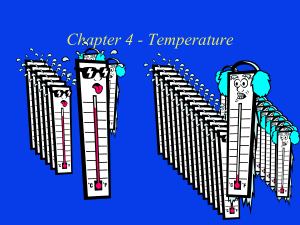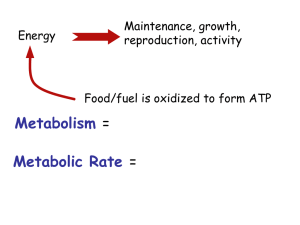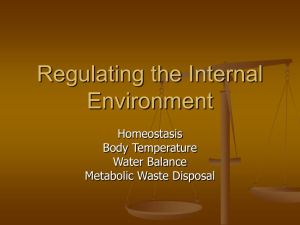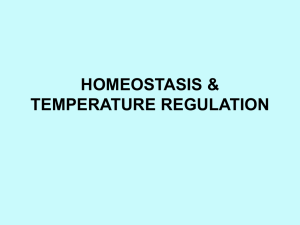TEMPERATURE - USD Biology
advertisement
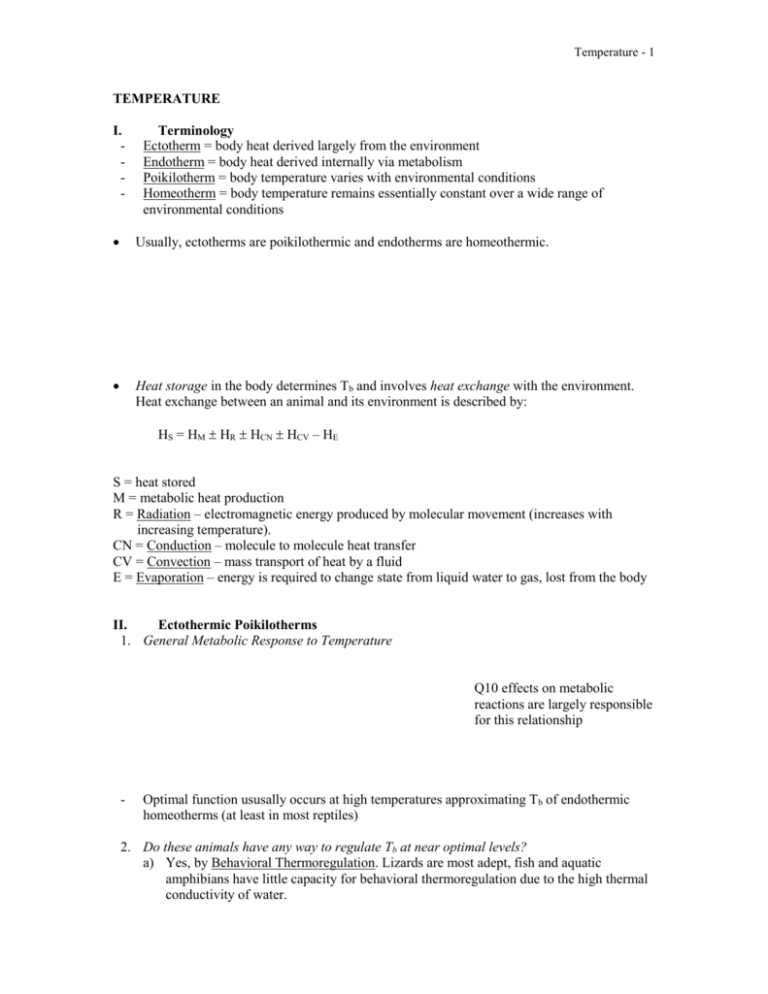
Temperature - 1 TEMPERATURE I. - Terminology Ectotherm = body heat derived largely from the environment Endotherm = body heat derived internally via metabolism Poikilotherm = body temperature varies with environmental conditions Homeotherm = body temperature remains essentially constant over a wide range of environmental conditions Usually, ectotherms are poikilothermic and endotherms are homeothermic. Heat storage in the body determines Tb and involves heat exchange with the environment. Heat exchange between an animal and its environment is described by: HS = HM HR HCN HCV – HE S = heat stored M = metabolic heat production R = Radiation – electromagnetic energy produced by molecular movement (increases with increasing temperature). CN = Conduction – molecule to molecule heat transfer CV = Convection – mass transport of heat by a fluid E = Evaporation – energy is required to change state from liquid water to gas, lost from the body II. Ectothermic Poikilotherms 1. General Metabolic Response to Temperature Q10 effects on metabolic reactions are largely responsible for this relationship - Optimal function ususally occurs at high temperatures approximating Tb of endothermic homeotherms (at least in most reptiles) 2. Do these animals have any way to regulate Tb at near optimal levels? a) Yes, by Behavioral Thermoregulation. Lizards are most adept, fish and aquatic amphibians have little capacity for behavioral thermoregulation due to the high thermal conductivity of water. Temperature - 2 - - Eccritic Temperature = Preferred Tb = temperature around which the animal regulates if given the opportunity. Eccritic temperatures usually provide near optimal metabolic performance. However, the animal does not have to be at its eccritic temperature to be active. b) Main source for behavioral thermoregulation is solar radiation. Using heat from the sun, many terrestrial ectotherms (esp. lizards) are capable of keeping Tb close to their eccritic temperature under a wide range of environmental temperatures. (Overhead, Willmer et al., p. 449) When Ta is cold, orient themselves perpendicular to sun’s rays to receive maximum amount of radiation; when Ta is warm, orient parallel to sun’s rays to decrease solar energy uptake. If Ta is too hot, seek shade or burrow (microclimate selection) c) Also can change peripheral circulation to modify heating and cooling rates (warming generally occurs faster than cooling). (Overhead, Willmer et al., p. 451) 3. Exceptions to General Ectotherm Thermal Response A) Tunas and some Sharks – metabolic heat production by red muscle, used in steady cruising swimming, is retained within the body core by a countercurrent heat exchanger between the body core (warm) and skin and gill circulation (cold). Muscle temperature may be as much as 14C higher than water temperature. B) Insects (moths, bumblebees, some dragonflies, wasps, beetles and flies) – for flight, nerve cord and muscle temperatures must be at least 30-35C, but these insects often fly at cool temperatures (as low as 5C). How is this accomplished? - Produce heat by isometric contraction (shivering) of thoracic flight muscles, with countercurrent exchange to keep warm “blood” in thoracic region. (Overhead, Willmer et al., p. 457) - Also, non-shivering thermogenesis may play a role (futile cycling of PFK and FBPase in bumblebees) C) Python – contraction of trunk musculature coiled around eggs increases Tb about 4-5C above Ta for incubation of eggs. (Overhead, Willmer et al., p. 454) D) Inertial Homeothermy – large terrestrial ectotherms have a low surface area to volume ratio, so they lose heat very slowly to the environment. Because of this, they are capable of basic homeothermy simply due to their large size, especially in warm climates. 4. Freezing Avoidance and Tolerance A) Freezing damages tissues and causes cell death by several mechanisms: 1) disruption of membranes by ice formation 2) increased solute concentration of remaining fluid osmotic shock 3) decreased metabolic exchange as ECF freezes B) Freezing Avoidance = mechanisms preventing freezing of body fluids at subfreezing temperatures. Occurs in insects, fish, amphibians, and some reptiles. 1) Supercooling = cooling to a level below the freezing point of the body fluids without ice formation. - Can be important for short-term, or even relatively long-term survival of freezing temperatures. - Dangerous because if ice crystal forms, remaining fluid rapidly freezes. - Hatchling painted turtles provide a good example of this strategy. Overwinter in nest, where temperatures can go as low as -12C. Freezing point of body fluids is about Temperature - 3 0.6C, but these turtles can supercool in excess of -10C. If they freeze in supercooled state, however, they die. 2) Colligative Anti-freeze = act to reduce freezing point of body fluids due to the number of molecules in solution. - Fish NaCl, glucose - Amphibians glucose, glycerol - Insects polyhydric alcohols 3) Non-colligative Anti-freeze = act by physically preventing (due to chemical properties) addition of water molecules to the crystal lattice structure of ice. - Glycopeptides, Polypeptides in fish, especially arctic and Antarctic fishes - (Overhead, Willmer et al., p. 206) C) Freezing Tolerance = tolerate certain amount of freezing of body fluids (up to 60-70% of total body water as ice in some species). - Limit freezing to ECF. Plasma membrane resists penetration of ice crystals. Nucleating agents may initiate ice formation in ECF. - Much of water in cytoplasm is “bound” to cell macromolecules and cryoprotectant molecules, so is not available for ice formation. - Occurs in some insects, intertidal molluscs, some terrestrially wintering frogs, Siberian salamander, and European Wall Lizard. Also, to a limited extent (physiologically relevant?) in garter snakes and hatchling painted turtles. III. ENDOTHERMIC HOMEOTHERMS 1. Heat Production occurs via metabolism (HM) and balances heat loss so that Tb remains constant. - Mathematical Expression: MR = C (Tb – Ta) - MR = heat production (usually measured by oxygen consumption) - C = thermal conductance = measure of net heat transfer between animal and environment. Equivalent to 1/insulation, or MR/(Tb – Ta). - Conductance can be modified by: a) plumage or pelage adjustment b) postural adjustments c) peripheral circulation adjustments d) changes in (Tb – Ta) gradient 2. General Metabolic Response to Temperature Temperature - 4 - - - - Thermoneutral Zone = range of temperatures over which metabolic HP is unaffected by changes in Ta. Tb kept constant over this range by passive changes in conductance via plumage/pelage adjustments, postural adjustments, and peripheral vasoconstriction or vasodilation. Lower Critical Temperature (LCT) = temperature below which an endotherm must increase metabolic HP to maintain constant Tb. Actually LCT is a gradual transition rather than a sharp demarcation. Insulation is theoretically maximized at LCT. Upper Critical Temperature (UCT) = temperature above which an endotherm must increase metabolic HP for heat dissipation mechanisms (e.g., panting, sweating). UCT occurs at T a just below Tb. Summit Metabolism = maximum HP in the cold. Below temperatures eliciting summit metabolism, endotherm cannot keep up with heat loss and begins to become hypothermic. TNZ is relatively larger for large animals (due to surface area considerations and they are capable of increasing insulation more than small animals) and for well insulated (coldadapted) animals. (Overhead, Willmer et al., p. 224) Large animals are capable of seasonal changes in insulation (modifies LCT), but small endotherms have little capacity for changing insulation due to small size, so they generally show little seasonal variation in insulation (Handout, Schmidt-Nielson, p. 258) The slope of the line below LCT can be regarded as a measure of conductance (C), so LCT and slope are both affected by conductance (insulation). Cold adapted animals generally show reduced slopes. (Handout, Swanson 1991) 3. Mechanisms of Heat Production A) Exercise/Activity = heat produced as a by-product of activity may be used to supplement thermoregulation. Also, the Heat Increment of Feeding may supplement thermoregulatory heat production. (Handout, Webster and Weathers 1990) - Exercise is never used by cold-adapted endotherms as a major method for HP B) Shivering = involuntary muscle contraction to produce heat. Birds are best at shivering – they shiver isometrically so that the surface insulation is not disrupted. Mammals generally use shivering only when non-shivering thermogenesis (NST) is not sufficient. C) Non-shivering Thermogenesis (NST) = HP without muscular activity by uncoupling ATP production or by futile cycles. (i) Brown Adipose Tissue (BAT) = sole purpose is thermogenesis. Only found in mammals, especially in neonates, hibernators, and cold-adapted mammals. Located in cervical and thoracic regions close to CNS and heart. (ii) Mechanism = uncoupling of oxidative phosphorylation in mitochondria so the proton gradient is dissipated entirely as heat, rather than driving ATP synthesis. An Uncoupling Protein is involved. (Handout, Hochachka and Somero 1984) (iii) Birds lack BAT, but some evidence for the presence of NST exists a) MR begins to increase before shivering starts as Ta decreases b) At very cold Ta, shivering remains constant but MR increases as Ta decreases 4. Facultative Hypothermia = Tb allowed to drop below normal levels - Torpor/Hibernation = state of dormancy where MR is low and Tb may approximate Ta. Torpor generally occurs on a daily basis, hibernation on a seasonal basis. - Not due to thermoregulatory failure, it is actually a carefully regulated state and allows great energy savings. - This condition is very important to the survival of many small endotherms (which have high MR) when the Ta is cold and food is scarce. Temperature - 5 - - - - Usually endotherms enter the torpid state only if they are unable to survive otherwise. However, some birds appear to use hypothermia to conserve fat stores for migration (hummingbirds, geese). The torpid state can be dangerous because when the animal is dormant, it can’t escape from predators. Distribution Among Endotherms: 1. Mammals = found in many small arctic or temperate-wintering species, up to about 5 kg. Large mammals don’t use deep torpor/hibernation because the thermal inertia that must be overcome to heat a large body during arousal is too expensive. Large animals show only minor reduction in Tb, so not true hibernation. - Hibernating mammals arouse (increase Tb) about every 2 weeks (up to 26 days in Arctic Ground Squirrels) when the may eliminate wastes, eat, or just sleep. Reason for arousal not known. - A number of mammals also use daily torpor bouts during rest phase of daily cycle. 2. Birds = Daily torpor documented for hummingbirds, swifts, mousebirds, bee-eaters, nightjars. Only the Common Poorwill hibernates (extended periods of torpor, up to 3 months of dormant state). Many endotherms (common among birds) use shallow regulated hypothermia (Tb may drop to 8-12C below normal values, but still responsive to stimuli) during rest phase of daily cycle to save energy. Still capable of activity (e.g., escape from predators) in this condition. Diagram of good torpid response: 5. Heat Dissipating Mechanisms – operate at Ta above UCT (HE must equal HMHRHCDHCV). A) Evaporative Cooling = heat energy used to change liquid water to vapor this heat is supplied by the body, thereby cooling it. 1) Panting = Evaporative Water Loss (EWL) from respiratory tract. - Panting efficiency = (HE/HM) X 100; Must be greater than 100% to be effective. Panting, or other EWL methods, work better in dry conditions than in humid conditions. Dog at Ta = 42C (Blue = no panting; Red = panting) - Animals that are good at panting use the tidal volume of the dead space of the respiratory tract, so they don’t blow off too much CO2 respiratory alkalosis. The potential for respiratory alkalosis is a major disadvantage to panting. Temperature - 6 - Gular Flutter = rapid vibration of the floor of the mouth and upper throat in birds. Increases HE over and above that from panting (Overhead, Willmer et al. pg. 213). Usually used in concert with panting. B) Sweating = cutaneous EWL. Requires low RH or wind to work well since no endogenous air flow is supplied (as in panting). C) Salivation = some rodents will lick fur and then EWL occurs from surface of fur. D) Urohydrosis = evaporation of excretory water from legs (vultures and cranes) 2) Hyperthermia Tolerance = tolerate a small gain in Tb (4-5C) above normal during hot conditions or during exercise. This acts to decrease the gradient for heat gain (or increase the gradient for heat loss during exercise), so less heat must be dissipated. Allows water savings. - Stored heat is dissipated when conditions become favorable (e.g., night or rest after activity) - Brain temperature is kept lower than body temperature by countercurrent heat exchangers know as carotid rete or rete mirabile ophthalmicum (Overhead, Willmer et al. pg. 210)

